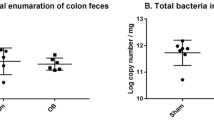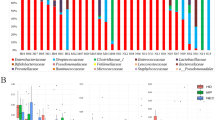Abstract
Intestinal resection results in loss of surface area, motor disruption, and an altered luminal milieu, all of which might influence bacterial growth. Our aim was to determine the effect of extensive intestinal resection in the dog on small intestinal bacterial flora and nutrient absorption. Ten dogs underwent 75% proximal intestinal resection and were killed at either 12 or 40 weeks. Five animals underwent transection alone and were killed at 12 weeks. Ileal aspirates were cultured. Nutritional status and nutrient absorption were measured every 4 weeks. Mean total and anaerobic ileal flora were increased after resection, significantly at 40 weeks. Overall, more cultures from resected animals had more than 5×106 total bacteria (6 of 10 vs. 0 of 10,P<0.05) and more than 105 anaerobic bacteria (5 of 10 vs. 0 of 10,P<0.05) than unoperated animals. Total but not anaerobic bacteria were increased after transection alone. Ingestion and absorption of carbohydrate decreased but absorption efficiency was maintained. Nitrogen intake decreased but excretion and absorption were unchanged. Fat intake decreased and excretion was unchanged resulting in decreased absorption. Mean intake, excretion, and absorption of nutrients were not influenced by the presence of significant growths of total (>5×106/ml) or anaerobic (>105/ml) bacteria. It was concluded that (1) 75% proximal intestinal resection results in significantly more aerobic and anaerobic bacteria in the ileal remnant; (2) intestinal bacterial content does not correlate with absorption of nutrients; and (3) the colon, and particularly colonic bacteria, may have a more important role in nutrient absorption than luminal flora in the small intestine after resection.
Similar content being viewed by others
References
King CE, Toskes PP. Small intestine bacterial overgrowth. Gastroenterology 1979;76:1035–1055.
Quigley EMM, Thompson JS. The motor response to intestinal resection: A study of motor activity in the canine small intestine following distal resection. Gastroenterology 1993; 105:791–798.
Thompson JS, Quigley EMM, Palmer JM, et al. Luminal short chain fatty acids and post-resection intestinal adaptation. JPEN 1996;20:338–343.
Briet F, Flourie B, Achour L, et al. Bacterial adaptation in patients with short bowel and colon in continuity. Gastroenterology 1995;109:1446–1453.
Myrvold H, Tindel MS, Isenberg HD. The nipple valve as a sphincter substitute for the ileocecal valve: Prevention of bacterial overgrowth in the small bowel. Surgery 1984;96:42–47.
Roe JH, Rice EW. A photometric method for the measurement of free pentoses in animal tissue. J Biol Chem 1954; 173:507–512.
VandeKamer JH, Huinink TB, Weyers HA. Rapid method for determination of fat in feces. J Biol Chem 1949;177:347–355.
Nordgaard I, Hansen BS, Mortensen PB. Colon as a digestive organ in patients with short bowel. Lancet 1994;343:373–376.
Bergmeyer HV, Bent E, Schmidt F, et al. In Methods of Enzymatic Analysis. Bergmeyer HV, ed. New York: Verlag Chemie, Weinheim/Academic Press, 1974, pp 1196–1201.
Corazza OR, Menozzi MG, Strocchi A, et al. The diagnosis of small bowel bacterial overgrowth: Reliability of jejunal culture and inadequacy of breath hydrogen testing. Gastroenterology 1990;98:302–307.
Cherbut C, Meivieu O, Ruckebusch Y. Effect of diet on intestinal xylose absorption in dogs. Dig Dis Sci 1996;31:385–391.
Ameen VZ, Powell GK, Jones JA. Quantitation of fecal carbohydrate excretion in patients with short bowel syndrome. Gastroenterology 1987;92:493–500.
Aghadassi E, Plapler H, Kurau R, et al. Colonic fermentation and nutritional recovery in rats with massive small bowel resection. Gastroenterology 1994;107:637–642.
Stahlgren LH, Umana G, Roy R, et al. A study of intestinal absorption in dogs following massive small intestinal resection and insertion of an antiperistaltic segment. Ann Surg 1962;156:483–492.
Hylander E, Ladefoged K, Jarnum S. Nitrogen absorption following small intestinal resection. Scand J Gastroenterol 1980;15:853–858.
Curtis KJ, Sleisenger MH, Kim YS. Protein digestion and absorption after massive bowel resection. Dig Dis Sci 1984;19:834–840.
Author information
Authors and Affiliations
Rights and permissions
About this article
Cite this article
Thompson, J.S., Quigley, E.M. Intestinal flora and nutrient absorption after intestinal resection. J Gastrointest Surg 1, 554–560 (1997). https://doi.org/10.1016/S1091-255X(97)80072-8
Issue Date:
DOI: https://doi.org/10.1016/S1091-255X(97)80072-8




